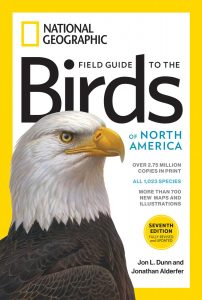Let me start by saying 2 things. First, I cannot answer the question posed in the post title. I have more field guides spread through my house than I can count. I have a hard time getting rid of books in general but field guides are never disposed of. Second, I LOVE field guides, including from places I may never visit. I prefer guides whose illustrations are paintings and not photos. I know not everyone agrees. The first field guide I ever owned was the Golden Guide to Birds and it served as the "textbook" for my first field ornithology class.
I still have it.
When I heard there was going to be a seventh edition of the National Geographic Field Guide to the Birds of North America I was excited to see what was new because this is the guide I carry in the field. At first glance it is very similar to the previous additions, it covers all of North America, it is a bit larger than many guides, it is heavy by field guide standards and a Bald Eagle is featured on the cover. However a closer looks shows some significant advances. Here is how the publisher describes it:
 About Field Guide To The Birds Of North America
About Field Guide To The Birds Of North America
ï Paperback:†592 pages
ï Publisher:†National Geographic; 7 edition (September 12, 2017)
This fully revised and updated edition of the best-selling North American bird field guide is the most up-to-date guide on the market.
Perfect for beginning to advanced birders, it is the only book organized to match the latest American Ornithologists' Union taxonomy. With more than 2.75 million copies in print, this perennial bestseller is the most frequently updated of all North American bird field guides. Filled with hand-painted illustrations from top nature artists, this latest edition is poised to become an instant must-have for every serious birder in the United States and Canada.
The 7th edition includes 37 new species for a total of 1,023 species. Sixteen new pages allow for 250 fresh illustrations, 80 new maps, and 350 map revisions. With taxonomy updated to recent significant scientific rearrangement, the addition of standardized banding codes, and text completely vetted by birding experts, this new edition will stand at the top of the list of birding field guides for years to come."
It's all this and more that will keep the National Geo guide as my go to book in the field. The book is reflective of our new knowledge about bird taxonomy based on DNA sequencing. A geneticist I know said that in 10 years we won't have to buy any new field guides because the taxonomy will be all figured out. We'll see. The new taxonomy has its pluses and minuses. I am excited to see the subspecies maps at the back of the book but the concept of subspecies is still being worked out (how many subspecies of Song Sparrow are there???) The rearrangement of the order of bird families is something to get used to. If you are good at flipping to specific sections of the guide without thinking about it you may be surprised where you land now.
As a bird bander myself the addition of the Bird Banding Laboratory 4-letter species codes is nice to see though I don't know how many people will use them as shorthand. In some birding groups people get upset if your mention an AMRO instead of saying or writing American Robin. I did find one error in the codes, the banding code for Yellow Warbler has been changed to YEWA whereas the guide lists the old YWAR. I don't know of any other errors.
It is a beautiful book with useful, detailed illustrations and descriptions. I recommend it as a top choice when friends ask for advice about buying a field guide.
You will not be disappointed.
Social Media
#fieldguidetothebirdsofnorthamerica @tlcbooktours.
1 comment:
Thanks for being on the tour!
Post a Comment